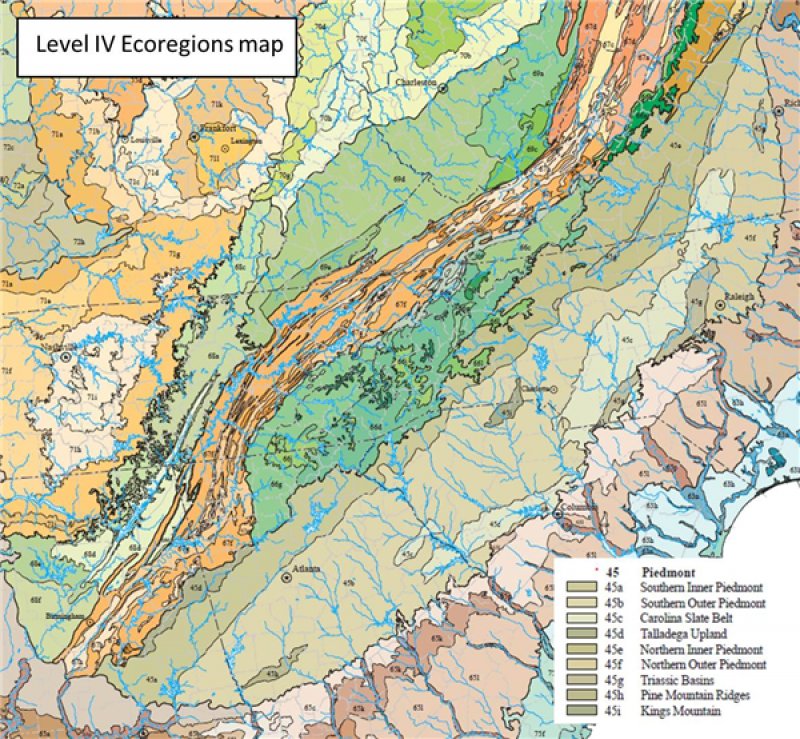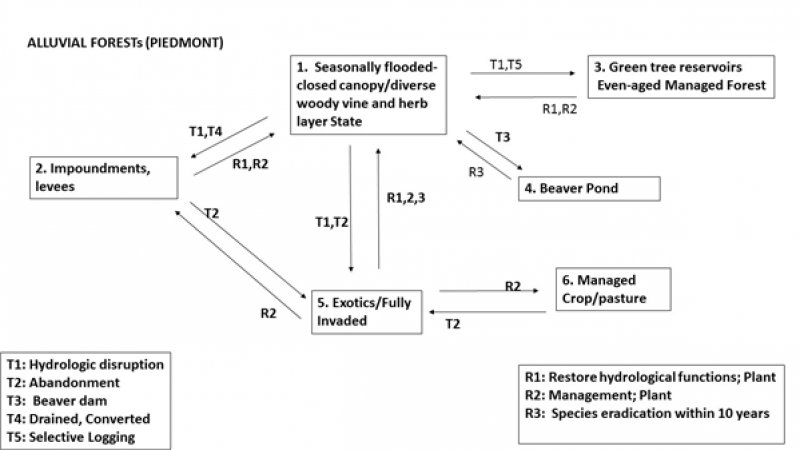
Natural Resources
Conservation Service
Ecological site PX136X00X640
Low Terraces and Drains, Occasional Inundation
Accessed: 04/18/2025
General information
Provisional. A provisional ecological site description has undergone quality control and quality assurance review. It contains a working state and transition model and enough information to identify the ecological site.
MLRA notes
Major Land Resource Area (MLRA): 136X–Southern Piedmont
This area is in North Carolina (29 percent), Georgia (27 percent), Virginia (21 percent), South Carolina (16 percent), and Alabama (7 percent). It makes up about 64,395 square miles (166,865 square kilometers). (Ag Bulletin 296)
The northeast-southwest trending Piedmont ecoregion comprises a transitional area between the mostly mountainous ecoregions of the Appalachians to the northwest and the relatively flat coastal plain to the southeast. It is a complex mosaic of Precambrian and Paleozoic metamorphic and igneous rocks with moderately dissected irregular plains and some hills. (EPA Ecoregions descriptions)
ADD APPROPRIATE ECOREGION DESCRIPTION(S)
Classification relationships
A PROVISIONAL ECOLOGICAL SITE is a conceptual grouping of soil map unit components within a Major Land Resource Area (MLRA) based on the similarities in response to management. Although there may be wide variability in the productivity of the soils grouped into a Provisional Site, the soil vegetation interactions as expressed in the State and Transition Model are similar and the management actions required to achieve objectives, whether maintaining the existing ecological state or managing for an alternative state, are similar. Provisional Sites are likely to be refined into more precise group during the process of meeting the APPROVED ECOLOGICAL SITE DESCRIPTION criteria.
This PROVISIONAL ECOLOGICAL SITE has been developed to meet the standards established in the National Ecological Site Handbook. The information associated with this ecological site does not meet the Approved Ecological Site Description Standard, but it has been through a Quality Control and Quality Assurance processes to assure consistency and completeness. Further investigations, reviews and correlations are necessary before it becomes an Approved Ecological Site Description.
Ecological site concept
This ecological site occurs on poorly drained hydric soils along flood plains, drainageways, and backswamps that are seasonally flooded. This site has pronounced hummock-and-hollow microtopography. The tree canopy is closed to partially open and dominated by Acer rubrum and Fraxinus pennsylvanica. Other canopy associates may include Nyssa sylvatica, Liquidambar styraciflua, Ulmus americana, Quercus lyrata, Quercus phellos, Quercus lyrata, and Populus heterophylla. The shrub layer includes Lindera benzoin, Leucothoe racemosa, Ilex verticillata, Viburnum spp., and Fraxinus pennsylvanica saplings. The herb layer is characterized by Saururus cernuus, Peltandra virginica, Boehmeria cylindrica, Triadenum walteri, Cinna arundinacea, Pilea pumila, Impatiens capensis, Osmunda regalis, Leersia oryzoides, Leersia virginica, Glyceria striata, Commelina virginica, Rumex verticillatus, Carex spp., and Polygonum arifolium.
Table 1. Dominant plant species
| Tree |
(1) Acer rubrum |
|---|---|
| Shrub |
(1) Saururus cernuus |
| Herbaceous |
Not specified |
Legacy ID
F136XY640VA
Click on box and path labels to scroll to the respective text.

